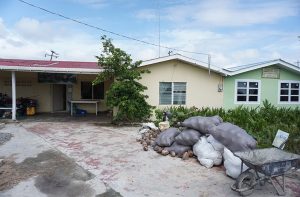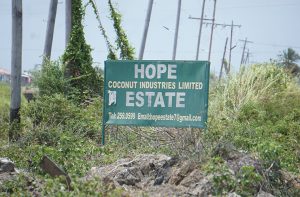By Michel Outridge

GENERAL Manager Ricky Roopchand of Hope Coconut Industries Limited (HCIL), commonly called ‘Hope Estate,’ told the Pepperpot Magazine that the entity is working assiduously towards achieving its goal. He stated that HCIL’s current drive is to better serve farmers’ needs and at the same time work towards achieving financial sustainability and wean itself off government’s subvention.
He reported that it is no secret and is unfortunate that the estate suffered almost two decades of mismanagement. However, with the support of the present government, the situation has changed for the better over the past three years. This was made possible through the support received from the Ministry of Agriculture.
He stated that in an effort to address many of the setbacks and overcome several hurdles that hindered progress, the estate has embarked on several income-generating projects with the aim of creating the pathway for development.

Roopchand added that one such project is its fully established and functional coconut nursery which, over the past three years, has become one of the estate’s main income streams. It has the capacity to produce 100,000 coconut seedlings per year and is one of the most productive nurseries, not only in Guyana, but in the entire Caribbean.
“This intervention augurs well for farmers since they now have easy access to high-quality seedlings at an affordable cost. As a direct result of the nursery’s robust, sustainable and commercial drive, the estate was able to win both technical and financial support from several international development agencies such as the CARICOM Development Fund (CDF) through the Rural Agricultural Infrastructure Development Project (RAID) which falls under the umbrella of the Ministry of Agriculture, The Caribbean Agricultural Research and Development Institute (CARDI) and ITC, which is funded under the 11th European Development Fund (EDF),” he said.

He disclosed that Hope Estate is now turning the corner and farmers’ needs are better served. The support received is now acting as a “springboard” for the continued development and expansion of the coconut sector of Guyana, making it commercialised and productive for the benefit of all involved.
Roopchand pointed out that today, the tide has turned for the better, since over the past three years close to $35 million was expended to fix several bridges, dams, the main access road, extension and repairs of the main office building, establishing of a coconut nursery and coconut demonstration plot, to name a few.
In addition, HCIL has embarked on a programme to continue to improve and maintain the essential infrastructure of the estate, he said.
The Pepperpot Magazine also spoke to HCIL Accounts Clerk Trishwantie Jagdeo, who said that they sell coconut plants which are sourced from farmers in Demerara, Essequibo and Berbice.
She disclosed that they have a staff of seven and they open from Mondays to Fridays from 08:00hrs to 16:00hrs
The accounts clerk stated that they have a wide array of coconut plants housed in nursery bins from 18 months, three years and five years old.
Jagdeo pointed out that they have three species of coconut plants, namely: the St. Lucian green, the St. Lucian yellow and the Malaysian dwarf.
“We sell the coconut plants as low as $300, $350 and $700 per plant and per month we buy about 1,500 coconut plants from farmers, but we have a lot of five-year-old coconut plants presently, since it [sic] takes a while to sell,” she said.



.jpg)








